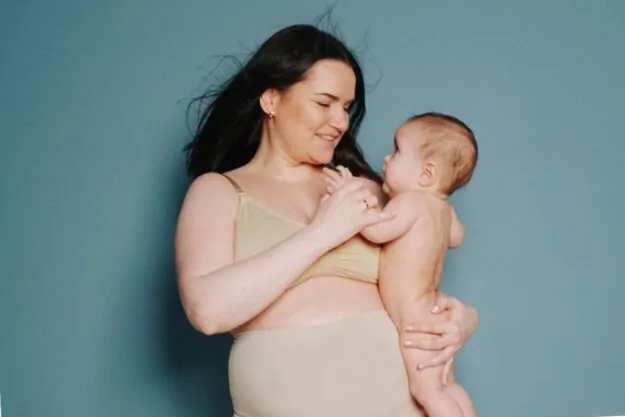Having a baby is a truly exciting but also quite challenging life experience. The first challenge you will face as a new mother is healing after birth and postpartum care. Caring for yourself after birth is essential for your health and the health of your new baby.
Taking care of your new baby will be a lot of work, but it's equally important to care for yourself to be the best mother you can be. This includes your physical health and your mental health.
In this article, you will find:
- What to Expect After Birth
- What to Avoid
- Postpartum Essentials
- Postpartum To-Do List & What to Watch Out For

What to Expect During Your Postpartum Recovery
1. Minimal Pain & Discomfort
Some pain and discomfort are expected after having a baby, whether you had a vaginal birth or a c-section.
Some of the pain to be expected is vaginal soreness and burning, especially if you tore or had an episiotomy. Your first bowel movement can also be uncomfortable. Be sure to talk to your doctor about checking for hemorrhoids, which can often come from pushing in labor.
2. Bleeding
Bleeding and vaginal discharge are both normal parts of the postpartum period. You will bleed afterward, whether you have a vaginal birth or a c-section. And while the bleeding is different for everyone, there are general postpartum guidelines on how much is too much, what to expect, etc.
3. Contractions
Some moms are surprised to find out that the contractions don't stop after giving birth, although they are much milder. These contractions are especially noticeable while you're nursing your baby. You will notice that as you nurse, your body starts to contract. Your body continues to contract to help shrink your uterus back down.
These contractions shouldn't be excruciating, but they can be uncomfortable. Many women compare it to the pain of period cramps.
4. Pain With Breastfeeding
Breastfeeding can also be painful for various reasons. Most women are likely to experience discomfort while their breasts are getting used to nursing. Sometimes your nipples may crack or bleed as they build up a tolerance. To help with breastfeeding pain, try using nipple cream. You can also use a nipple shield temporarily to give your nipples a chance to heal. The tenderness and pain can last for a couple of weeks.
You can also experience discomfort from engorgement. When your milk comes in, you will have much more milk than your baby can drink. To relieve engorgement, try pumping or hand expressing.
If the pain doesn't seem to get any better, it's best to see a lactation consultant or your doctor to determine if there are any other possible causes, such as a tongue or lip tie, poor latch, etc. You can also experience pain from infection, so it's best to see your doctor to rule that out.
5. Hormone Overload
After birth, you might feel as if you're on a hormonal rollercoaster, and that's because you are. You can expect to feel highs and lows. While some sadness and moodiness are typical for the first couple of weeks, often called baby blues, they should go away on their own. If it does not go away, you should talk to your doctor to ensure you aren't suffering from postpartum depression.
What to Avoid:
Having a baby is a big deal! It's not the same body you had before you conceived. Your body needs time to heal and time to readjust. There are a few things to avoid immediately after having a baby for your health and safety.
- Sex
- Baths
- Tampons/anything penetrative
- Vigorous exercise
- Certain medications (if you're breastfeeding)
Postpartum Essentials
While postpartum can be difficult, there are many things that you can utilize and take advantage of that can make the healing process easier on you. Build yourself a new mom care package, or ask for one from friends and family. Here are a few postpartum products you might find helpful for the first few days, weeks, or even months after birth.
1. Pain Management Must Haves
You will likely feel pain or discomfort in a few different areas after birth. If you have a c-section, your incision will probably be painful for some time. If you had a vaginal birth, your perineum and rectum might be sore for some time. You will have uncomfortable contractions, sometimes called afterpains, and breast tenderness for both delivery types.
Here are a few tools to help with postpartum pain management:
- Over the counter pain meds (ibuprofen, tylenol, etc.)
- Stool softener
- Sits bath
- Tucks witch hazel pads
- Dermoplast pain relieving spray
- Nipple cream
- Nipple shield
- Heating pad
- Ice pack
2. Pads & Underwear
Whether you have a vaginal delivery or a c-section, you will bleed vaginally after birth. You will bleed a significant amount the first couple of days after birth. At the hospital, they will give you large mesh underwear and large pads.
However, adult diapers are becoming much more popular for postpartum bleeding. They are much more comfortable, don't leak, and you can buy some that fit and look more like underwear.
3. Diaper & Breastfeeding Caddy
You need many things for your new baby, and you will likely need them in different areas of your house. A caddy is an excellent way to ensure you have everything you need, and it's easy to carry from room to room with one hand.
A few things you might add to your caddy are diapers, wipes, rash cream, nipple cream, burp rag, nipple shield, nursing cover, etc.
4. Water Bottle
It's important to drink a lot of water after having your baby, especially if you're breastfeeding. Getting yourself a good water bottle is a must. One with a straw or an easy-to-open lid is ideal, as you will likely only have one hand most of the time.
5. Easy Meals
The last thing you will want to do after having a baby is cook meals for your family. Meals that are quick and easy are a must! One practice that has become common is to prepare meals ahead of time and freeze them, so they just need to be thawed and reheated. Postpartum freezer meals can be a lifesaver for new moms.
Another tip for meal time that many new moms take advantage of is to buy paper or plastic dishes so that you don't have to do dishes for the first little while after getting home.
6. Comfortable Clothes
Depending on your delivery, the clothing you wear afterward will differ. If you had a c-section, you would want clothes with a loose waistband to prevent irritating your incision. You might also like stretchy clothes, as it can take some time to shrink back to your pre-pregnancy clothing.
If you are going to breastfeed, nursing bras and shirts are very convenient. They make nursing, especially in public, much easier.
7. Snacks & Drinks
Having snacks and drinks on hand is essential for a couple of reasons. First, you might not get a lot of time to dedicate to sitting down and eating a meal, so you might have to sneak in some snacks when you have the time.
Breastfeeding can also make you feel hungry more often. Snacks and some hydrating drinks can be a lifesaver for late nights or middays when you are nursing your baby.
8. Breastpump or Haaka
A pump can be a great tool even if you plan to breastfeed exclusively and don't plan to pump. After you have your baby and your milk comes in, you will produce much more milk than your baby will need. This will lead to feeling engorged, and that can be painful. You can pump to release some of that pressure and discomfort.
A handheld pump that has become popular is the haka. These are small enough to fit in the diaper bag and are excellent at expressing as much or as little milk as you want. Haakas can also be used as a milk catcher.
Things to Add to Your Postpartum To-Do List
1. Set Up A Follow Up Appointment With Your Doctor
Your doctor will likely want you to come in and get a postpartum check-up to ensure you've healed well. The typical time for this appointment is six weeks postpartum. This is when your doctor will clear you for sex, postpartum exercise, etc.
2. Get On Birth Control
One thing your doctor will likely ask you about at your postpartum appointment is whether or not you would like to get on birth control. It can be hard on your body if you become pregnant within a year of giving birth, so it can be a good idea to use some form of birth control or contraception.
3. Take Note of Things to Watch Out For
It can be hard to know what to expect postpartum, as every person heals differently, and it can also differ with each birth. But there are a few things that everyone should be watchful for that you should consider and consult with your doctor about.
- Blood clots larger than the size of a golf ball or hemorrhaging
- Postpartum depression, anxiety, or rage
- Extreme pain
- Signs of infection
In Conclusion: Postpartum Care
Postpartum healing is going to look different for every person. It's essential to prioritize caring for yourself while recovering from childbirth. Take plenty of comfort measures, get as much sleep as possible, and don't be afraid to reach out to your health care provider if you have questions or concerns. Enjoy your time with your newborn!
This post originally appeared on Hello Sensible by Kayla.
Sylvia Silverstone is a passionate writer who loves to share her knowledge and expertise on a wide range of topics, including beauty, life hacks, entertainment, health, news, and money. With a keen eye for detail and a talent for storytelling, Sylvia's engaging writing style keeps readers coming back for more.


Leave a Reply